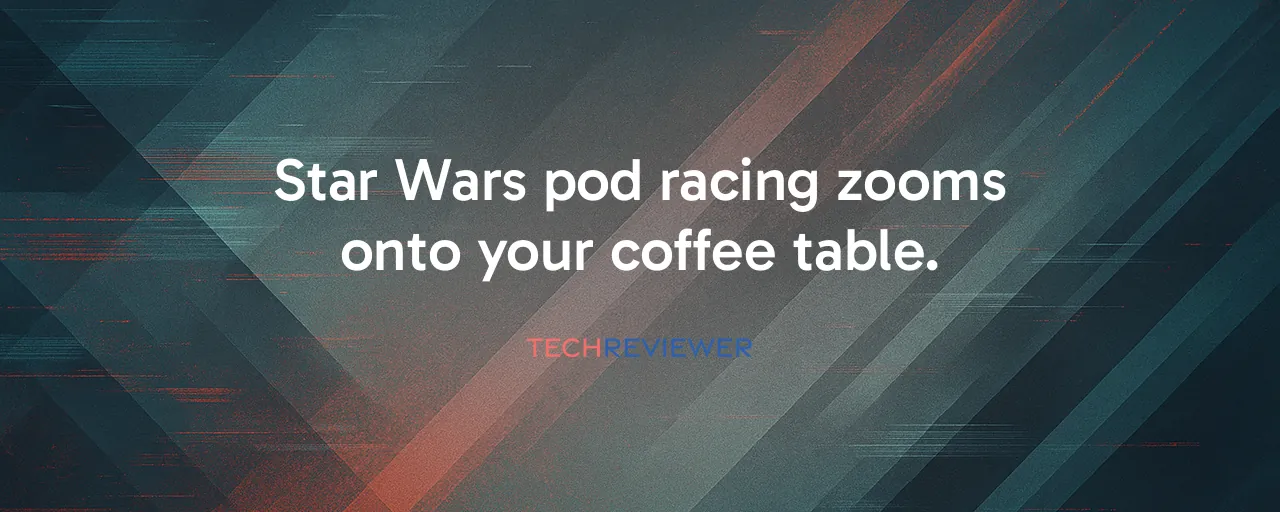A New Spin on Star Wars Gaming
Star Wars Beyond Victory, launched on October 7, 2025, for Meta Quest 3 and 3S, delivers a fresh approach for fans who grew up racing toy pods across their bedroom floors. This mixed reality experience weaves digital Star Wars magic into your actual surroundings, steering away from traditional virtual reality dives. Users can steer a pod racer around a tabletop track that sprawls across their coffee table or place a tiny Sebulba figure on their bookshelf. Industrial Light and Magic and Lucasfilm, leveraging decades of Star Wars visual storytelling, developed Star Wars Beyond Victory for Meta Quest 3 and 3S, marking a significant milestone as ILM's first large-scale mixed reality Star Wars project.
The game offers three modes, each tapping into a different slice of fandom. Adventure mode follows Volo Bolus, a rookie pilot mentored by the sneaky Sebulba, in a story set during the Empire's reign. Arcade mode turns your room into a competitive pod racing circuit, complete with leaderboards. Playset mode acts as a digital toy box where you can resize and pose Star Wars characters like action figures. It captures childhood nostalgia while showcasing technology that would impress younger selves.
Racing Through Your Living Room
Arcade mode's tabletop pod racing stands out, transforming physical spaces into miniature Tatooine speedways. Using Quest 3's full-color RGB passthrough cameras, the game maps room layouts to anchor virtual tracks and obstacles, leveraging improved visual fidelity over previous generations. Players control their pod from a third-person view, leaning in to navigate tight turns or dodge debris. The experience focuses on orchestrating a high-stakes toy race rather than replicating the heart-pounding cockpit thrills of 1999's Episode I Racer. Early players, as noted in UploadVR's October 6 review, praised the 'wow factor' of seeing furniture become part of the course, though some desired deeper racing mechanics after repeated sessions.
For fans in their 40s, this mode sparks nostalgia, recalling hours spent staging battles with plastic X-wings. One fan, quoted in a Road to VR review, described it as 'like my childhood toys came to life.' Younger players, however, found the third-person perspective less intense than expected, craving a first-person cockpit option. The game's spatial mapping, powered by Qualcomm's Snapdragon XR2 Gen 2 chipset, maintains smooth performance with stable frame rates during chaotic races. Still, the tech isn't perfect, as some players reported slight warping in the passthrough visuals, a quirk Meta's 2025 firmware updates haven't fully ironed out.
A Digital Toy Box for All Ages
Playset mode stands out for sheer creativity. Users can grab a digital Boba Fett, scale him to fit on a desk, and pose him next to a tiny Millennium Falcon. This mode, built on ILM's expertise from projects like Vader Immortal, enables manipulation of Star Wars assets with intuitive Touch controller gestures. Its low intensity makes it accessible for kids and parents, resonating as a family-friendly option. Reviews from October 7 note how this mode evokes memories of collecting Kenner action figures in the '80s among older fans, while younger players enjoy building their own galactic scenes.
The design reflects a broader trend toward gaming that reduces isolation. Unlike traditional VR, mixed reality maintains connection to the environment. This makes Beyond Victory a social experience where roommates or family can watch or join. However, the lack of multiplayer limits its potential for shared play, a missed opportunity given the success of social VR hits like Beat Saber. Still, the mode's accessibility and charm demonstrate mixed reality's place in casual gaming.
Behind the Galaxy's Tech
Creating Beyond Victory extended beyond applying Star Wars skins to new technology. ILM's team, including veterans from Tales from the Galaxy's Edge, adapted a VR tool used by Hollywood directors to stage scenes. Director Jose Perez III and his crew transformed this into a consumer game, blending full VR immersion with mixed reality's room-aware capabilities. The result of ILM's development work allows seamless shifts between modes, such as moving from Volo's story to a tabletop race without disrupting narrative flow. Skywalker Sound's spatial audio, paired with voice performances from a full cast including Bobby Moynihan, Fin Argus, Greg Proops, Lilimar Hernandez, and Lewis MacLeod, delivers polish reminiscent of Star Wars films.
Technical limitations remain. The two-to-three-hour campaign feels short for its $19.99 price tag, especially compared to expansive titles like Jedi Fallen Order. Some players, per Road to VR, found the constant switching between VR and mixed reality jarring and desired an option to stick with one perspective. The game's exclusivity to Quest 3 and 3S also narrows its audience, excluding Quest 2 owners despite their headset's popularity. These challenges indicate mixed reality gaming is still evolving, but ILM's effort sets a high standard for possibilities.
What It Means for Gaming's Future
Beyond Victory offers a glimpse into gaming's potential direction. Meta's $2 billion investment in Quest's ecosystem, with a 30% engagement boost in 2024, signals strong commitment to mixed reality. The game's release alongside Quest 3S's $300 price point aims to attract new players during the 2025 holiday rush. For Disney and Lucasfilm, it keeps Star Wars fresh for younger fans while tapping into the nostalgia of those who grew up with the prequels. Industry observers view it as a test case for franchises from Marvel to Harry Potter to explore mixed reality's possibilities.
Challenges persist. The game's single-player focus misses the social engagement of titles like Gorilla Tag, and its hardware exclusivity risks alienating a broader VR crowd. Reviews suggest the tech, while impressive, needs refinement, with dynamic room interactions remaining a pipe dream. Still, Beyond Victory illustrates how major franchises can evolve beyond traditional games, blending physical and digital worlds in innovative yet familiar ways. For fans and newcomers, it presents a compelling reason to strap on a headset and race into the galaxy.
